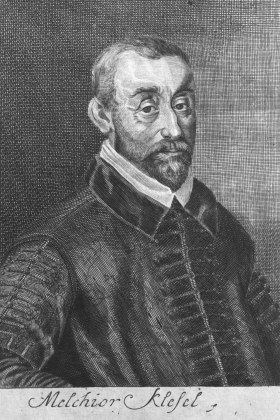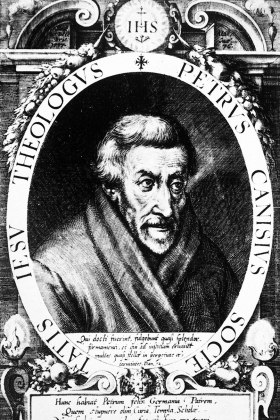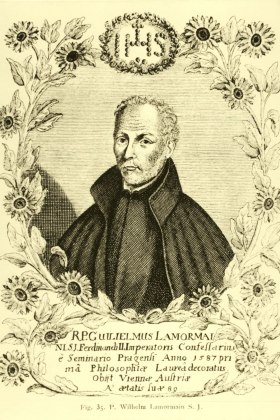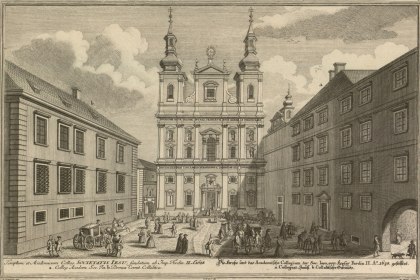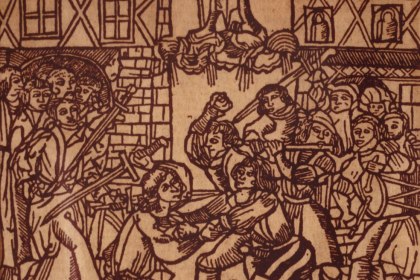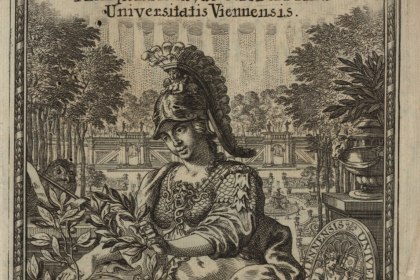The Society of Jesus and the University of Vienna
Three years mark the history of the Jesuits at the University of Vienna: In 1550 the order was called to Vienna by the sovereign King Ferdinand I, in 1623 the Jesuit College was incorporated into the university and finally in 1773 the order was suppressed by decree of Pope Clement XIV, which ended the Viennese Jesuit College.
After Martin Luther’s reformation had arrived in the Habsburg territory and especially in the city of Vienna, Ferdinand I took measures to stabilize his reign and to reform Christian life in his lands. In this, the University of Vienna had a central role: As cradle of the Catholic clergy and training center for future state officials. In 1533 and 1537 reform laws were implemented, which aimed to transform the medieval university corporation into a Catholic state university.
Ferdinand I brings the Society of Jesus to Vienna (1550/51)
The young Society of Jesus, which had devoted itself to the “salvation of souls”, caught the eye of King Ferdinand I. One of the closest companions of the order’s founder Ignatius of Loyola, Claudius Jajus (Claude Jay), won the sovereign’s trust and founded an interest group at the 1550 Diet of Augsburg. This group would shape the future Austrian educational system. The sovereign was in the process of consolidating his reign based on Catholicism. In this, he had found a potential partner in the Society of Jesus, which could be presented as the “savior” of the decaying Catholic educational system. Although the Society of Jesus did not see itself as a teaching order, youth work soon became one of its main tasks. An “inner mission” was supposed to answer the muddled denominational situation in the Catholic areas. To achieve this they wanted to approach the malleable youth. The order’s founder Ignatius of Loyola “knew of no better device against the universal German sickness than using impeccable and religious men at the universities”. King Ferdinand’s initiative to found a Jesuit College in Vienna was welcomed by Ignatius as a divine inspiration. For the college’s establishment Ferdinand asked for a delegation of two order members who also were to lecture at the Faculty of Theology. Claudius Jajus was the first to arrive in Vienna from Ingolstadt on April 25, 1551. Soon after, a second group of eleven Jesuits arrived from Rome. They received accommodations in a desolate side wing of the Dominican monastery. The priests immediately began lecturing at the Faculty of Theology. Claudius Jajus reported to Rome that there were “good professors of the humanities, Greek, Hebrew, philosophy, medicine and law at the university”, but that he suspected some of them of “heresy”. Competent professors were scarce, but those who were not “loyal Catholics” should still be dismissed in his opinion. At first the idea to base all subjects apart from law and medicine at the Jesuit College and to establish publically accessible studies there could not be put into practice. This idea became the starting point of altercations between the university and Jesuits. At the same time Ferdinand achieved the sending of Petrus Canisius to Vienna, who was supposed to continue the university reform. He wanted to invigorate the university and make it attractive by appointing studied professors with Jesuit teaching methods to teaching positions and through the good example of successful Jesuit scholars. In 1553 Canisius joined the reform commission and spoke out for the dismissal of “heretic” professors. Replacing all non-Catholics at the university with Jesuits would have failed due to the lack of personnel. Canisius took a hard line and succeeded in getting the head of the school of the Protestant estates and professor at the Faculty of Arts, Nikolaus Polites from Brussels, incarcerated and banished from the country. Canisius regretted the punishment’s “leniency” in a letter to the Jesuit Superior General. He was of the opinion it would encourage the “damned plague among professors and students”, while the university was feeding “monsters and heretics”.
The Reformatio Nova
On January 1, 1554, the university obtained a new constitutional charter, known as the “Reformatio Nova”. It drove back the medieval corporative character and expanded the sovereign’s influence in the university. Certain authors and books were prescribed for the compulsory lectures and the chairs were given to state-funded professors. The collegiate funds, which had been the financial basis for independently lecturing doctors, were abolished and the right of co-optation was reduced to a vague nominating power for appointments. At the same time the sovereign improved the university’s economic basis. The verification of newly appointed professors’ religious confession was made less strict in a response to the available supply of personnel. It is not known how much Canisius himself or other Jesuits directly worked on the reform law. In any case, it remained the University of Vienna’s basic constitution until the Theresian-Josephinist reforms of the 18th century.
Catholic reform, education and denominational conflicts
Since the beginnings of the Catholic reform in Austria it was clear that the renewal of the parish and pastoral clergy could not exclusively come from the reservoir of students of the Society of Jesus. The flourishing Trivial school in the Jesuit College, in which grammar and humanities were taught, also began educating external students. In 1553 the university had hesitantly given its approval to the establishment of a public school. When the priests added a philosophical course of studies, also accepted students from outside of the order and even gave master’s degrees to non-Jesuits, the “casus belli” was given. Not even Pope Pius IV could change this when he gave the order the right to establish Jesuit Colleges with the right to award doctorates in artistic and theological subjects in 1561. For more than 50 years the fight over the allocation of responsibilities continued. The university repeatedly demanded the suspension of public lessons in the College and the complete “abolishment of Jesuits” in Vienna, since they drew students to their College in “dishonest competition”. Not least because of their tuition-free education, the Jesuits had up to 1000 students. Tenaciously, the university defended its old monopoly on education and its old privileges. It was threatened with the consolidation of the university and college and with it the end of the university corporation.
Counter-Reformation
While access to the university for non-Catholics had been facilitated under Emperor Maximilian II (1564-1576) and even Protestant rectors and professors had been tolerated, under Emperor Rudolf II (1576-1612) the turbulent “Khlesl era” followed, which was marked by counter-reformational measures. In 1578 the rightfully elected rector was deposed because he refused to participate in the Corpus Christi procession. Melchior Khlesl, from a Protestant Viennese family, Jesuit student and later archbishop of Vienna, became dean of St. Stephen’s cathedral and university chancellor in 1579. He enacted an obligatory Roman-Catholic profession of faith for all graduates. Although Khlesl had vehemently opposed the Jesuits’ interests as university rector and had wanted to withdraw both of their chairs of theology, a reform commission was established under his rule, which for the first time discussed handing over all philosophical studies to the Jesuits in 1609. The four faculties wrote lengthy assessments of this idea, prophesying the “ruin of the whole university”. Even the theologians, who highly praised the Jesuits, stressed the “impossibility” of this plan – an “impossible” plan which finally became a reality after turbulent disputes.
“Hostile takeover” of two faculties by the Societas Jesu
In 1623 the Viennese Jesuit College was incorporated into the university by decree of Emperor Ferdinand II. The order received most of the professorships at the Faculty of Theology and all at the Faculty of Philosophy. At the same time the university’s buildings and several bursae – except for the jurists’ and physicians’ buildings – were given to the Society of Jesus with the mandate to construct the Academic College (“Collegium Academicum Viennense Societatis Jesu”) complete with a church, theater, library and observatory in their place. The classes of the Faculties of Theology and Philosophy were to be held in this new college. As a consequence of the Jesuit College’s incorporation, a “double-tracked” administration was developed. The Jesuit College’s “Father rector” was responsible for his order’s brothers and students, but could not be elected university rector, while the rector conversely could not be a member of the Society of Jesus. In 1628 the rectorate moved into a house at Sonnenfelsgasse 19 – today called “domus antiqua” – which was provided by the Jesuits. Until the relocation into the Ring palace in 1884 this remained the headquarters of the university administration.
The Jesuits’ work at the university
More than 2000 high school pupils and students were educated by 17-20 priests at the Academic College. Apart from the Faculty of Theology, the priests supervised six high school classes (parvists, principists, grammatists, syntaxists, poets, rhetors) and the subjects of the Faculty of Philosophy (logic, physics, metaphysics). Besides their teaching work the Jesuits from the Viennese college often also stood out through research. People who should be highlighted include Fr. Paul Guldin (1577-1643), who wrote mathematical-astronomical works (“Guldinus theorem”) and who was in contact with Johannes Kepler. Other famous Jesuits working in mathematics were Fr. Gabriel Frölich (1657-1725) and Fr. Franz Rescalli (1651-1713). In the historical sciences productive order members included the author of the “Annales Austriae” and the “Annales ecclesiastici Germaniae”, Fr. Sigismund Calles (1695-1761) or Fr. Franz Molindes (1678-1768) who wrote a “Synopsis historiae universalis” until Emperor Charles VI. In the natural sciences particularly the all-round talented Fr. Joseph Franz (1704-1776) should be mentioned, who founded a widely recognized “Museum mathematicum” with equipment for optics, astronomy, geography, geometry etc. and later was head of the observatory built in 1733. Fr. Maximilian Hell (1720-1792) acquired a good reputation in the field of astronomy as director of the observatory and through his calculation of the ephemerides (tables of the daily positions of celestial bodies), which were publicized in 37 volumes.
When Pope Clement XIV suppressed the Society of Jesus in 1773, the order’s possessions were integrated into the study fund and the Academic College and the Jesuit church were gifted to the university. Some of the “ex-Jesuits” continued teaching and doing research at the University of Vienna.
-
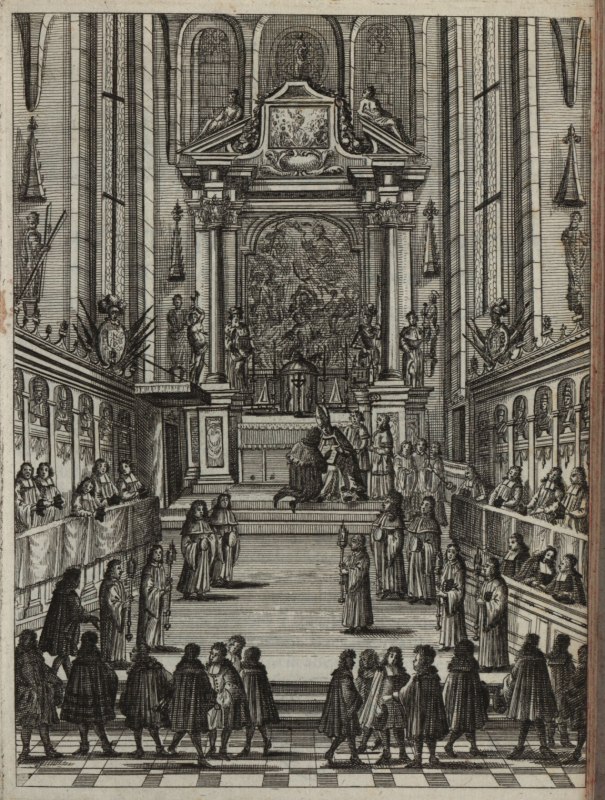
Eid des Rektors auf die unbefleckte Empfängnis Mariens (Immaculata-Eid)
Der Rektor der Universität Wien legt in der Stephanskirche vor dem Hochaltar den Eid auf die unbefleckte Empfängnis Mariens ab (Kupferstich von G. C...
Zuletzt aktualisiert am 04/15/24
-
Ferdinand I. (Habsburg), Erzherzog von Österreich
10.3.1503–25.7.1564 -
Melchior Khlesl
19.2.1552–18.9.1630 -
Petrus Canisius
8.5.1521–21.12.1597 -
Wilhelm Lamormaini
29.12.1570–22.2.1648 -
Sigismund Calles SJ
12.3.1695–3.1.1767 -
Maximilian Hell (Höll)
15.5.1720–14.4.1792 -
Franz Rescalli
1651–1713 -
Ferdinand II. (Habsburg), Erzherzog von Österreich
9.7.1578–15.2.1637 -
Maria Theresia von Österreich (Habsburg)
13.5.1717–29.11.1780
-
University reforms under Ferdinand I.
1521–1554



